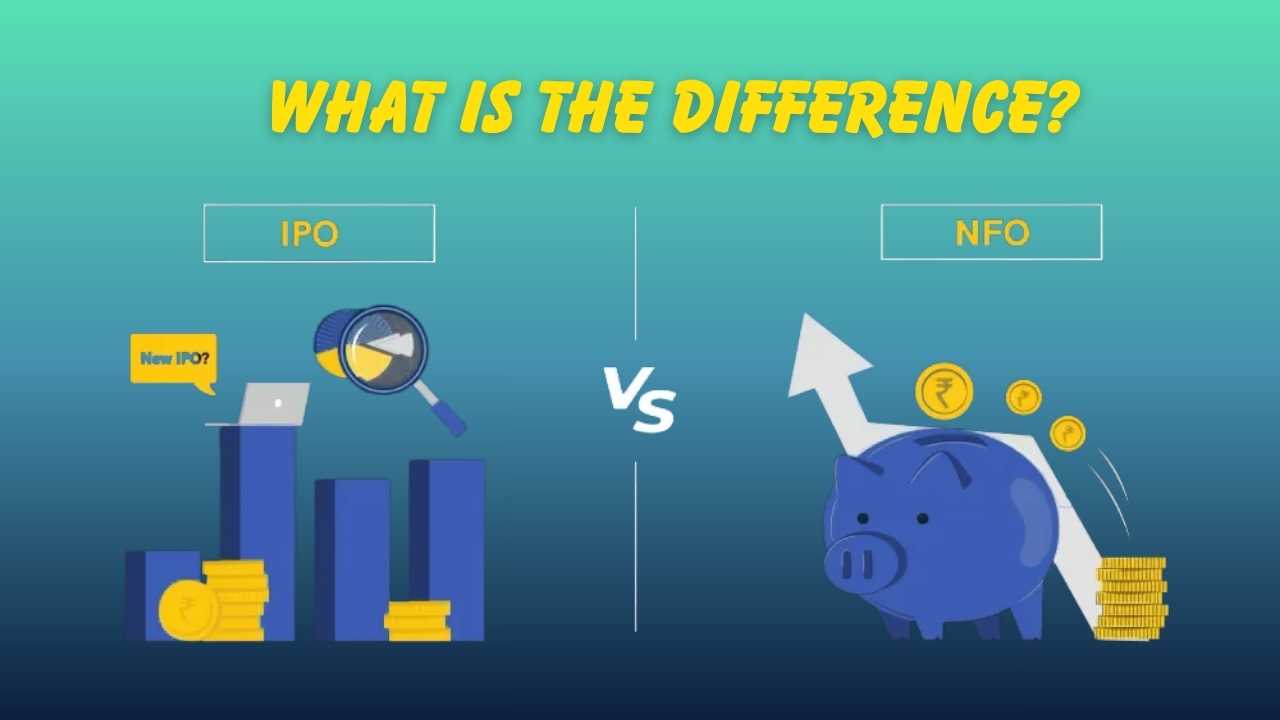Stepping into the investment world can feel overwhelming, especially when you encounter terms like NFO (New Fund Offer) and IPO (Initial Public Offering). Although both sound similar and involve new investment opportunities, they’re actually quite different.
Let me make it simple: an NFO lets you join a professionally managed mutual fund, while an IPO gives you a piece of ownership in a company. By the end of this guide, you’ll understand exactly what each means and which one might work better for your investment goals.
What is an NFO?
A New Fund Offer (NFO) is the launch of a brand-new mutual fund scheme by an asset management company(AMC). When an AMC creates a fresh mutual fund, they offers it to investors for the first time at a fixed price—usually ₹10 per unit in India.
During the NFO period (typically a few weeks), you can purchase units at this introductory price. Once this window closes, the fund starts trading at its Net Asset Value (NAV), which changes daily based on how the market performs.
Key Features of NFOs
NFOs have some unique characteristics. The entry price stays fixed at ₹10 per unit during the launch phase. You can only buy during the limited offer period. After launch, professional fund managers handle all investment decisions on your behalf. The fund could be open-ended (where you can buy and sell anytime) or closed-ended (with specific entry and exit timings).
Here’s a quick example: If HDFC launches a “Tech Growth Fund” NFO, you could buy units at ₹10 each during the offer period. Once it starts operating, the NAV moves up and down based on how the underlying tech stocks perform.
What is an IPO?
An Initial Public Offering (IPO) happens when a private company decides to go public by selling its shares to investors for the first time. When you buy an IPO, you’re actually purchasing a small ownership stake in that company.
Companies launch IPOs to raise money for expansion, paying off debts, or funding new projects. After the IPO, these shares get listed on stock exchanges like NSE or BSE, where anyone can buy and sell them.
Key Features of IPOs
With an IPO, you become a partial owner of the company. The share price gets determined through either a fixed-price method or a book-building process based on investor demand. Once listed, the stock price moves based on how well the company performs and what the market thinks about it.
Let me give you a real example: Zomato’s IPO was priced at ₹76 per share. If the price jumped to ₹120 after listing, early investors made a profit. But if it fell to ₹60, they faced losses.
Key Differences Between NFO and IPO
Here’s a clear comparison that shows how different these two really are:
| Aspect | NFO | IPO |
|---|---|---|
| What You Buy | Mutual fund units | Company shares |
| Who Offers It | Asset Management Company | A company going public |
| Entry Price | Usually ₹10 per unit | Based on company valuation |
| Ownership | No direct ownership | You own part of the company |
| Where It Trades | Based on NAV | Stock exchanges |
| Risk Level | Moderate | Higher |
| Management | Professional fund managers | You manage it yourself |
| Returns | Market-linked, diversified | Depends on company performance |
How NFOs Work
When an AMC decides to launch a new mutual fund, they submit detailed documents to SEBI for approval. Once approved, they announce the NFO with specific details about what the fund will invest in and its goals.
Step-by-Step Process
- Launch Announcement: AMC announces details like objective, category, and duration.
- Subscription Period: Investors can buy units at a fixed price (usually ₹10).
- Fund Mobilization: Money collected is pooled and invested as per fund objectives.
- NAV Declaration: After the NFO closes, the NAV is calculated daily.
- Regular Trading: Investors can buy or sell based on the NAV.
Why People Choose NFOs
NFOs offer access to new investment themes that might not be available in existing funds. The low entry price of ₹10 feels psychologically attractive. Plus, you get professional management without needing to be a market expert yourself.
But here’s something important: NFOs have no track record. Unlike existing mutual funds where you can check past performance, NFOs are essentially unproven. You’re trusting the fund manager’s skills without any historical data to back it up.
How IPOs Work
The IPO process is more complex and heavily regulated. A company first files detailed paperwork with SEBI, including information about its business, finances, and risks. After SEBI approves it, the company announces the IPO date and price range.
Step-by-Step Process
- Preparation and Filing: The company files a Draft Red Herring Prospectus (DRHP) with SEBI.
- Approval: Once approved, the IPO date and price range are announced.
- Subscription Period: Investors apply for shares within the offer period.
- Allotment: Shares are allotted to investors based on demand.
- Listing: The shares are listed on stock exchanges for trading.
Why People Choose IPOs
IPOs offer the excitement of getting in early on a company’s public journey. There’s potential for quick profits if the stock performs well on listing day. Long-term investors see IPOs as chances to own promising companies right from the start.
But not all IPOs deliver instant profits. Some list below their issue price because of poor market conditions or overpricing. Research and timing matter a lot here.
Understanding the Risks
Both NFOs and IPOs carry their own risk and reward profiles.
NFO Risks
Without past performance to look at, you’re betting on the fund manager’s ability to deliver results. Market ups and downs affect returns. Different fund managers have different track records. Plus, there’s no guarantee the new investment strategy will work as planned.
IPO Risks
IPOs can swing wildly in price during the first few days or weeks. Companies might be overpriced during the IPO hype. If the business doesn’t perform well, your investment suffers. Even good companies can see their stock prices drop during bad market conditions.
Which One Should You Choose?
There’s no one-size-fits-all answer. Your choice depends on your personality as an investor, how much risk you can handle, and what you want to achieve financially.
Choose NFOs if you:
- Prefer hands-off investing with professionals managing your money
- Want your investment spread across multiple stocks or bonds
- Are comfortable with moderate returns and moderate risk
- Trust the AMC’s track record and believe in the fund manager’s skills
Choose IPOs if you:
- Enjoy researching individual companies
- Can handle watching your investment value jump around
- Are willing to actively keep track of your holdings
- Have higher risk tolerance for potentially bigger rewards
Think of it this way: NFOs are like hiring a financial advisor to build and manage a diversified portfolio for you. IPOs are like picking individual stocks yourself and managing them on your own.
Tax Implications of NFO and IPO
For NFO Investors
Your tax depends on whether you’re in equity funds or debt funds. Equity funds held for over a year get taxed at 10% on profits above ₹1 lakh (long-term capital gains). Short-term gains (less than a year) get taxed at 15%. Debt funds follow different rules with higher tax rates.
For IPO Investors
If you sell shares within a year, you pay 15% tax on profits (short-term). If you hold for more than a year, you pay 10% tax on profits above ₹1 lakh (long-term). You also pay Securities Transaction Tax on every trade.
How to Apply for an NFO or IPO
Applying for an NFO
You can invest directly through the AMC’s website or app. Popular investment platforms like Groww, Zerodha Coin, or Paytm Money also work. Your bank or financial advisor can help too. The process is simple—fill in your details, choose how much to invest, and complete KYC if you haven’t already.
Applying for an IPO
You need a demat account linked to a trading account. Apply through your bank’s net banking using ASBA (your money stays blocked in your account until allotment). Most modern apps like Zerodha, Groww, or Angel One offer easy UPI-based IPO applications.
Common Myths You Should Know
“NFOs are cheaper at ₹10, so they’re better value”
This is misleading. The ₹10 price doesn’t mean better value. What matters is the fund’s strategy and how good the fund manager is. An existing fund at ₹50 NAV might actually be a smarter choice than a brand new one at ₹10.
“All IPOs give guaranteed profits on listing day”
Not true at all. Many IPOs list flat or even below their issue price. Market mood, company fundamentals, and pricing all affect what happens on listing day.
“NFOs and IPOs are basically the same thing”
They’re completely different. One is a pooled investment managed by professionals. The other is direct ownership in a company. The risks, management styles, and how returns work are totally different.
Final Thoughts
Both NFOs and IPOs have their place in a smart investment strategy. NFOs offer professional management and diversification, making them good for investors who want market exposure without becoming experts. IPOs provide direct ownership and potential for bigger gains, appealing to those who enjoy active investing.
Many experienced investors use both. They keep mutual fund investments (including some NFOs) for stability while selectively jumping into promising IPOs for growth.
Remember, neither guarantees profits. Success comes from understanding what you’re putting your money into, making sure it fits your goals, and keeping realistic expectations about returns and risks.
Learn More:
- Common Mistakes in Commodity Trading & How to Avoid Them
- Impact of Geopolitics and Natural Disasters on Commodities
- How to Open a Commodity Trading Account: A Step-by-Step Guide
- What is the Difference Between a Commodity and a Product?
- Square Off Process in the Commodity Market
FAQs: NFO and IPO
Can you invest in both NFOs and IPOs at the same time?
Yes, definitely. Many investors spread their money across both mutual funds and direct equity investments.
Do NFOs always start at ₹10?
In India, most NFOs are priced at ₹10 per unit. International funds might have different pricing.
How long should you hold IPO shares?
It depends on your plan. Some investors book quick profits on listing day, while others hold for years based on how strong the company is.
Are NFOs safer than IPOs?
Generally yes, because NFOs spread your money across multiple securities, reducing the risk of any single company failing. IPOs concentrate your risk in one company.
Can you lose all your money in NFOs or IPOs?
While rare, big losses are possible in both. NFOs can drop significantly if markets crash. IPO companies can fail or perform badly. Always invest only what you can afford to lose without affecting your daily life.













